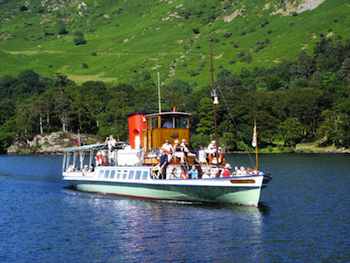- MENU
- HOME
- SEARCH
- WORLD
- MAIN
- AFRICA
- ASIA
- BALKANS
- EUROPE
- LATIN AMERICA
- MIDDLE EAST
- United Kingdom
- United States
- Argentina
- Australia
- Austria
- Benelux
- Brazil
- Canada
- China
- France
- Germany
- Greece
- Hungary
- India
- Indonesia
- Ireland
- Israel
- Italy
- Japan
- Korea
- Mexico
- New Zealand
- Pakistan
- Philippines
- Poland
- Russia
- South Africa
- Spain
- Taiwan
- Turkey
- USA
- BUSINESS
- WEALTH
- STOCKS
- TECH
- HEALTH
- LIFESTYLE
- ENTERTAINMENT
- SPORTS
- RSS
- iHaveNet.com: Travel
By Rick Steves

North England's Lake District
Boats in North England's Lake District help sightseers enjoy the natural beauty.
The Lake District is North England's lush, green, mountain playground. For more than a century, these lakes have attracted nature lovers. Whether hiking along a lonely windblown ridge, climbing over a rock fence to look into the eyes of a ragamuffin sheep, or stumbling over an ancient stone bridge, you'll find that the region gives even tenderfeet a chance to feel very outdoorsy.
The district's southern lakes are handier to London and more promoted, but I like to focus on the northern lakes -- Ullswater, Buttermere,and Derwentwater -- which are every bit as scenic, with nowhere near the crowds.
I like to make the town of Keswick, near Derwentwater Lake, my home base. It was an important mining center through the Middle Ages, but slate, copper, and lead gave way to tree-hugging tourists in the 19th century.
Last summer, I struggled up and over Catbells, a 1,480-foot hill above Derwentwater -- a walk I've recommended for years (and felt guilty having never actually hiked it in its entirety). The weather almost kept me in, but I was glad I ventured out. Atop Catbells, I welcomed the wind "blowing the cobwebs out" (as my B&B host warned), the comedic baaing of sheep, and being "the stick figure on the ridge" for those observing from distant farms or boats on the lake ... as others have been the stick figures for me.
And, oh, the joy of a pub after a good hike. Studying the light on ruddy faces while sipping the local brew has always been part of the magic of travel in Britain. When your face is weather-stung and your legs ache happily with accomplishment, a pub's ambience sparkles even brighter.
The hike confirmed my impression about the weather: In Britain, don't wait for it to get better. Blustery winds and wet skies are part of the scene; consider them a blessing. The majority of "bad weather" comes with broken spells of brightness. As they say here, there's no bad weather ... just inappropriate clothing. And if you're in a hiking area and your clothing is inappropriate, your B&B host can likely loan you a heavy coat (along with the best local map).
When you're done hiking, Keswick is a delight for wandering. Its centerpiece, Moot Hall (meaning "meeting hall"), was a 16th-century copper warehouse. Graphite was first discovered here centuries ago. A hunk of the stuff proved great for marking sheep in the 15th century. In 1832, the first crude Keswick pencil factory opened; today one old factory now houses the
Keswick also has a museum dedicated to all things Bond ... James Bond. It features an impressive collection of cars from each movie, starting with the dragon tank from "Dr. No" all the way to the Aston Martin DBS V12 from "Quantum of Solace." For many, it's more exciting than pencils.
While you're here, you'll discover that English holiday-makers take their dogs with them on vacation. The town square can look like the Westminster Dog Show, and the Dog and Gun pub, where "well-behaved dogs are welcomed," is always full of patient pups. If you are shy about connecting with people, pal up to an English pooch -- you will often find they are happy to introduce you to their owners.
About three miles east of Keswick, there's a mini-Stonehenge drenched in Lake District beauty -- the Castlerigg Stone Circle. For some reason, 70 percent of England's stone circles are here in the northern region of Cumbria. Castlerigg is one of the best and oldest in Britain, and an easy stop for drivers. The circle -- 90 feet across and 5,000 years old -- has 38 stones mysteriously laid out on a line between the two tallest peaks on the horizon. They served as a celestial calendar for ritual celebrations.
Imagine this setting as ancient people filled the clearing in spring to celebrate fertility, in late summer to commemorate the harvest, and in the winter to mark the winter solstice and the coming renewal of light. Festival dates were dictated by how the sun rose and set in relation to the stones. The more that modern academics study this circle, the more meaning they find in the placement of the stones. For maximum "goose pimples" -- as they say in England -- be here at sunset.
The Lake District is a land where nature rules, and humanity keeps a wide-eyed but low profile. The weather, like a dark army, storms overhead. Hiking along a ridge, buffeted by wind, and marveling at the commanding, 360-degree view makes me relax, recharge, and ready to write a poem.
© Rick Steves' Europe
AUTOS | HOBBIES | EDUCATION | FAMILY | FASHION | FOOD & RECIPES | HOME DECOR | RELATIONSHIPS | PARENTING | PETS | TRAVEL | WOMEN
Travel | Plunging Into North England's Lake District